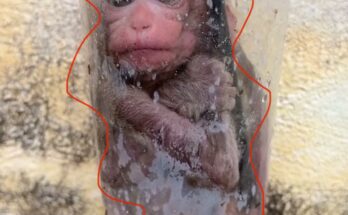In a quiet corner of a forest where wildlife and human activity often overlap, a tragic incident recently occurred that has drawn attention to the delicate balance between nature and development. A small monkey, known by local villagers for its playful behavior and curious nature, lost its life instantly after being struck by a falling piece of wood. Though accidents like this may seem rare, they highlight a much broader issue—how even small changes in the environment can pose serious risks to the animals that inhabit it.
According to residents who frequently observed the monkey, it was part of a small troop that lived near the edge of the forest. These monkeys were often seen foraging for food, jumping between branches, and occasionally approaching nearby homes in search of fruit. Their presence had become a routine part of daily life for the community, and many people felt a quiet fondness toward them.
The incident took place near an area where a few workers were clearing fallen branches and old, decaying wood. The workers reported that the small monkey appeared suddenly, most likely out of curiosity, unaware of the dangers nearby. As one of the larger pieces of wood was being moved, it slipped unexpectedly and struck the monkey. The impact was immediate, and the animal died on the spot. The workers, who were visibly shaken, said they had no intention of harming any wildlife and were deeply saddened by what happened.
This event has prompted local officials and community members to reconsider safety measures when conducting any activity near forested or wildlife-rich areas. While habitat loss and environmental degradation are well-known issues, accidental deaths resulting from human activities—even seemingly harmless tasks like clearing wood—serve as a reminder of how closely human and animal worlds are intertwined. A single misjudgment or unexpected movement can lead to irreversible consequences.
Conservation groups in the region have emphasized the importance of creating buffer zones where wildlife can move freely without being exposed to unnecessary risks. They also encourage workers and residents to remain alert whenever performing outdoor tasks, especially in areas frequented by animals. Simple measures, such as checking surroundings before lifting or moving heavy objects, can significantly reduce the likelihood of accidents.
The small monkey’s sudden death has left many in the community reflecting on the fragility of wildlife and the responsibility humans share in protecting it. While nothing can undo the loss, the incident serves as an important reminder of why awareness and caution are essential whenever human activity intersects with natural habitats.
In the end, this unfortunate event highlights a larger truth: preserving wildlife is not only about protecting animals from deliberate harm, but also about recognizing the many subtle ways our actions may unintentionally endanger them. Through greater care and consideration, such tragedies can be prevented, allowing creatures like the little monkey to live safely in the environment they call home.



